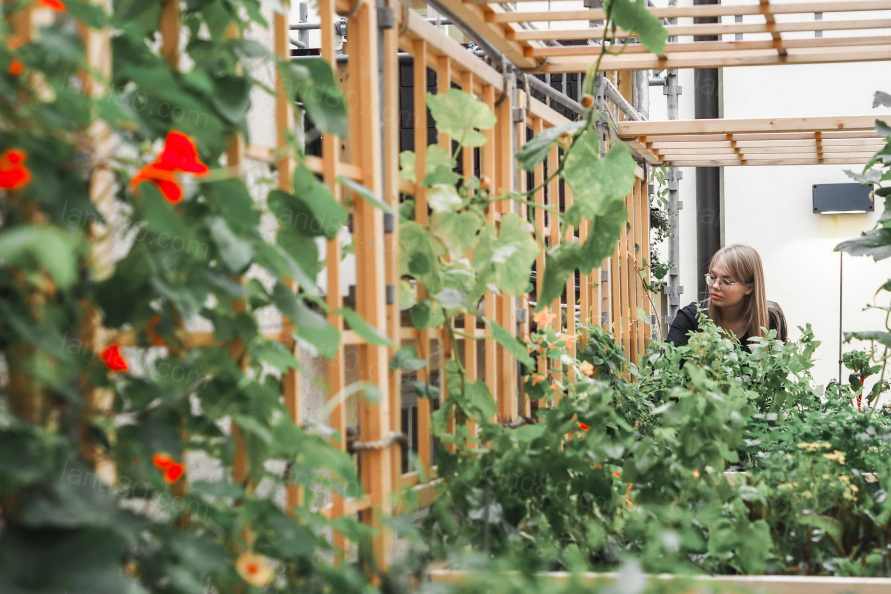在离我们居住地数百公里之外的地方种植食物是唯一的选择吗,还是我们可以依靠当地种植的饮食?我们是否可以通过利用城市空隙种植食物来改善废弃空间的质量,变得更加自给自足,并对我们的消费和留下的东西负责?如果我们的建筑能提供种植的生产,会怎样?
Is growing food hundreds of kilometres away from where we live the only option, or could we instead depend on a diet that is locally grown? Could we improve the quality of disused spaces by using the urban voids for growing food, becoming more self-sufficient and responsible for what we consume and leave behind? What if our buildings replicated the cycles of life?

Kasvattamo大致可译为 "种植园",是赫尔辛基市博物馆院子里的一个临时装置,让赫尔辛基人,尤其是年轻人参与到城市农业的概念中来。整个夏天,这个结构与居住在其中的植物一起不断生长,以一种模拟植物生命周期的方式,在收获季节结束时被拆除,并在赫尔辛基的一个温室里重新使用。
‘Kasvattamo’, which can be roughly translated as ‘Growery’, was a temporary installation at the courtyard of the Helsinki City Museum engaging the people of Helsinki and especially the youth with the concepts of urban farming. The structure kept growing throughout the summer together with the plants inhabiting it, in a way mimicking the plants life cycle, and by the end of the harvest season was dismantled and reused at a greenhouse in Helsinki.

Kasvattamo是一个关于如何利用赫尔辛基的荒芜庭院种植可食用植物的先锋项目。它是一个可以复制和重新组装的原型,以利用城市的废弃空间生产我们自己的食物。在夏季,这个空间满足了各种需求和社区实践活动,为赫尔辛基人提供了一个餐厅、工作室、户外电影院和聚会空间。
Kasvattamo is a pioneering project on how to utilise the barren courtyards of Helsinki for growing edible plants. It is a prototype that can be replicated and reassembled for harnessing the disused spaces of the city for producing our own food. The space served various needs and hands-on community activities through the course of summer, hosting activities of a restaurant, workshop space, outdoor cinema and a hangout space for the people of Helsinki.


模块化脚手架系统构成了临时装置的主体结构。所有配件的设计都考虑到将由志愿者们在车间里搭建。凉棚、屋顶和桌子都是用亮橙色的带子和麻绳连接或悬挂起来的。考虑到流行病的影响,桌子之间的距离保持在安全范围内。桌子之间的凹处有座位,供阅读或工作时使用,周围是植物。可折叠的桌子和屋顶让Kasvattamo前有更多的空间在公共活动和放映期间。
Modular scaffolding system forms the main structure of the temporary installation. All fitting parts were designed keeping in mind they will be built by volunteers during workshops. Pergolas, roofs and tables were attached or hanged using bright orange straps and sisal ropes. Tables are located apart from each other keeping safe distances considering the pandemic in mind. Recesses in between the tables have seats for reading or working surrounded by the plants. Foldable tables and roof allow more space in front of Kasvattamo during public events and screenings.


Kasvattamo是赫尔辛基城市博物馆展览的一部分。Kasvattamo旨在将博物馆的庭院变成一个城市绿洲。这是一个实验,旨在了解这样一个发展模块的潜力,它可以用于整个城市几乎所有的废弃空间,使人们能够在当地种植食物。
Kasvattamo was part of an exhibition at the Helsinki City Museum. Kasvattamo aimed to turn the courtyard of the museum into an urban oasis. It was an experiment to understand the potential for such a module of development which can be used in almost every disused space across the city enabling people to grow food locally.


▽项目概念 Concept

▽轴侧图 Axonometric drawing

▽平面图 Plan

▽平面图 Plan

▽立面图 Elevation

▽构造大样 Section

Project: Kasvattamo
Architecture Firm : ROOH studio
Design Team : Joonas Parviainen, Ella Prokkola, Shreyansh Sett, Ramya Nandyala, Brett Mahon, Arya Kaushik, Saagar Tulshan
Project location: Helsinki Finland
InnoGreen- https://innogreen.fi/en/
HÖRBS- https://horbs.fi/?page_id=212
Blokgarden- https://www.blokgarden.com/
Livvex Oy - scaffolding company
Pilkenetti Oy - furniture company - www.pilkenetti.fi
Photo Credits : Aki Markkanen
|